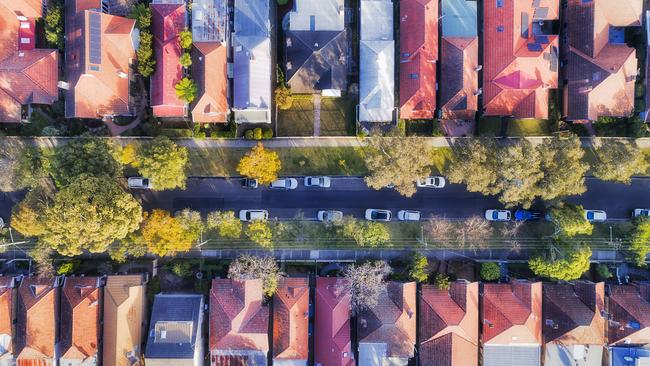Taxing the family home the ultimate in pariah policies
As boomer wealth soars, housing affordability is on the verge of dividing Australia into a nation of haves and have-nots.

At the centre of one of Australia’s most sacred myths is the family home. It represents security, continuity and the ability of the Australian economy to provide a middle-class lifestyle to millions. To paraphrase Paul Keating, who was both a tax reformer as treasurer and a slayer of tax reform as prime minister, the parrot in the pet shop is talking about housing affordability.
The debate over housing affordability is hampered by two related issues, the first of which gets in the way of sensible discussion of any type of tax reform. The Liberal Party’s sacred cow is that it is a party of low tax. But taxes have to pay for spending sooner or later.
Unless governments are prepared to significantly and permanently lower their expenditure levels, taxes inevitably have to rise. The travails of the Abbott government, in attempting to make expenditure cuts in some areas but actually increasing spending overall, are instructive. The point is that a broad tax base can’t afford large, arbitrary carve-outs such as the family home. While many Australians see home ownership as the first step towards financial security, the benefits of the tax loopholes flow mostly to the wealthiest citizens.
The second policy constraint when it comes to the family home is that politicians have no intention of making housing affordable in the most straightforward sense — allowing prices to fall via any combination of supply- or demand-side measures.
There is simply too much in the way of politics tied up in housing loopholes for governments to allow the redistribution of wealth that a sustained fall in housing prices might lead to. The power of the property ownership myth is so strong that adjusting the tax treatment of investors as well as of owner-occupiers has proven difficult. Indeed, the Howard government made the affordability problem worse by halving capital gains taxes. And Labor’s attempts at reform in these areas were met by a scare campaign at the last federal election. So where do we go from here?
Ideas on achieving fairer tax treatment of the family home have been wafting around for decades.
They spring from think tanks, interest groups and government reports – and they are always ignored by governments. The notion of a tax on land being the most efficient way to go has long attracted support because it can improve both equity and efficiency.
Moving from stamp duty on property transfers to a greater reliance on an annual tax on the unimproved value of land would swap one of the least-efficient government charges for one of most efficient. Labour could be more mobile in search of better wages and conditions, and a shorter commute; capital could be more lightly taxed. In an era of globalisation, one factor of production that isn’t going anywhere is land. Tax on land is transparent, difficult to evade, and easy to calibrate for equity purposes.
As the Henry Report put it, land tax has the potential to provide cash-poor state governments with “significant and sustainable revenue”. Revenue from stamp duty can be strong but it follows the cycle of the property market. It is an inefficient tax that stifles productivity. The extent to which states are reliant on this source of income is shown by the finding in the Henry Report that stamp duty on land transfers raised more than council rates and state land taxes combined. For states to have one of their largest sources of revenue subject to large variation plays havoc with their budgets. This is a major challenge when it comes to reforming this policy area under Australia’s federation. However, older homeowners could defer payment of the tax until after their estate was settled. This would be one way to help the theory of land taxes on the family home gel with the practical political challenges of such a policy objective.
Pressure to realise the increased value of a house would be less problematic, of course, where stamp duty has been abolished, making any replacement property cheaper. Changing from a poor to an efficient system will, of course, create winners and losers. And the sooner we accept that, the better. If politicians are not prepared to accept that some people will be worse off as a result of their policy reforms, they need to find another, less complex profession. Younger, more mobile professionals would benefit at the expense of retirees reluctant for a sea change or a tree change.
Reverse mortgages, for example, if priced right, could be a game changer, allowing people who really want to stay in their family home to do so and thus minimising the disadvantage.
But let’s be serious for a moment: retiring baby boomers who are well off enough to own their homes have lived through a period in which their wealth has exponentially soared because of the family home not being taxed. Low interest rates now hurt their retirement savings, but these could be used as a way of more easily accessing the cash locked into the family home — without the need to move or sell. If only a willingness to do so was embraced, or forced on them.
One of the problems, however, is that the population bubble of baby boomers has a disproportionate impact on electoral politics. While taxing the family home remains in the broader sense a pariah policy, in post-pandemic Australia it will at least increasingly be discussed. It may be that, just as competitive federalism saw all the other states follow Queensland’s abolition of death duties, the states will eventually be forced to provide a more rational tax treatment of land.
Governments that are skint lack the resources to conjure a more efficient tax system, while those that are flush lack the motivation. The last term of the Howard government saw billions wasted on income tax cuts and superannuation concessions. Granted, the hysterical reaction to its introduction of a GST would have tempered any politician’s appetite for reform. Yet the GST example shows that reform is possible when governments have the resources and the political will.

People do forget, however, what it took for that reform to make it onto the political agenda, and that the Howard-era reforms almost ended before they’d even really started. The landslide win the Coalition enjoyed in March 1996 was all but entirely taken away 2½ years later courtesy of the fight for GST reform.
The lesson many politicians of the future learnt watching what happened to Howard was: “Don’t reform if you want to retain a healthy majority.” This butted up against Howard’s personal view that the GST fight saved his government, which otherwise was drifting aimlessly. But the more capable political observers of Howard realised that if you do want to embark on major reform, it has to come early in the life cycle of a government – they saw that with Howard, and with Hawke before that.
When we look at the Morrison government – a third Liberal PM leading a third-term Coalition government – it isn’t hard to understand, in that context, why it’s disinclined to embrace major policy reform.
And despite the government already being long in the tooth, the Labor opposition, badly burnt by its attempt to campaign for major reform at the last election, also isn’t up for big policy changes. At least the idea of taxing the family home is one of the few areas in which states can pursue reform. Doing so would be easier with federal help, but we’ll take what we can get.
This is an edited extract from Who Dares Loses: Pariah Policies by Wayne Errington and Peter van Onselen, released on August 1 as part of Monash University Publishing’s In the National Interest series.






To join the conversation, please log in. Don't have an account? Register
Join the conversation, you are commenting as Logout